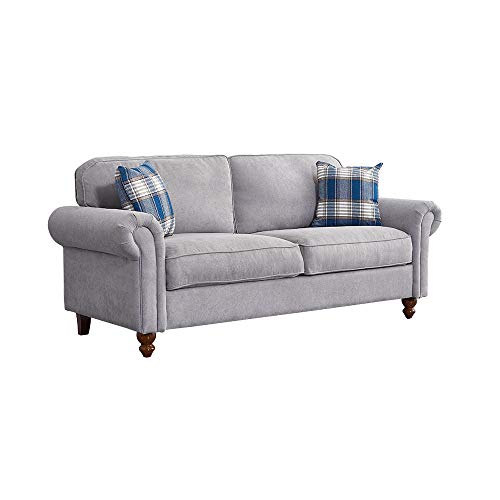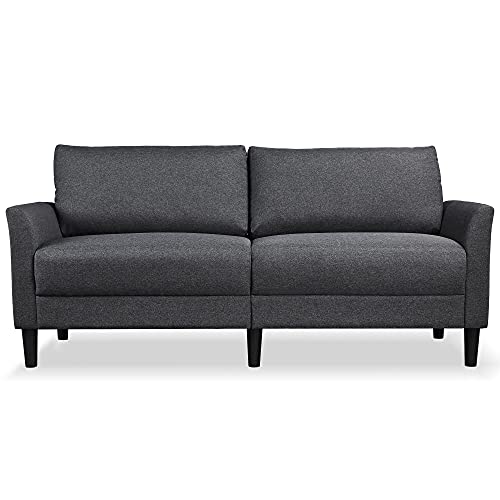Guide To 2 Seater Leather And Fabric Sofa: The Intermediate Guide To 2…
페이지 정보
작성자 Sharon 작성일 24-12-23 10:26 조회 2 댓글 0본문
 Choosing Between a 2 seater sofa fabric 2 seater fabric lounge leather And fabric sofa (hikvisiondb.webcam)
Choosing Between a 2 seater sofa fabric 2 seater fabric lounge leather And fabric sofa (hikvisiondb.webcam) If you're shopping for a new sofa, it can be tricky to choose between leather or fabric. This is especially true if you have little experience with furniture.
If you're shopping for a new sofa, it can be tricky to choose between leather or fabric. This is especially true if you have little experience with furniture.If you have children or live in a tiny apartment the leather option might be the best option for you. It is easy to clean and looks great in a lot of homes.
Comfort
The sofa is typically the focal point in many homes and is an important purchase. You want one that you can sit on for hours and is stylish, blends with your room style and will last for a long time. It isn't easy to choose between leather and fabric, however, you must take into consideration your budget, lifestyle, and other priorities before making a decision.
Leather is a high-end, luxurious material that exudes style and elegance in any home. It is durable and stain-resistant. It is also resistant to pets and children, and will last a long time if properly taken care of. It can be expensive initially and may require regular conditioning to avoid cracking or peeling.
Fabric sofas are available in a variety of colours, styles and fabrics and can be cheaper than leather sofas. They are also soft and more inviting with the capacity to feel "broken in" from the start. They are prone to dust mites and pet hairs, and may need more frequent cleaning. But, with the advancement of technology and performance fabrics there are now hypoallergenic options available.
Fabric sofas can last for up to 15 years if properly maintained. Regular vacuuming and deep cleaning will ensure that the fabric is free of odours, stains and dirt. They also can flatten and sag over time, just as leather. In addition, many couches made of 2 seat fabric sofa have been treated with chemical to make them stain-resistant as well as flame-resistant. These couches can release volatile organic chemicals that can cause allergies and affect the quality of indoor air.
Durability
When purchasing sofas, we typically choose fabrics that are incredibly robust, which is essential for those with pets and children. You don't need to spend lots of money up front if you're going to regret it after the first stain or claw. Also you shouldn't buy something that's cheap but isn't durable enough for everyday use.
Leather, however is extremely durable and has an incredible strength for tears. It can last up to four times longer than fabric and is naturally resistant to cracks, fading and flaking. It is also able to be conditioned to restore its natural oils and appear like new.
Fabrics are a cheaper alternative and are available in a variety of colors patterns, patterns, and textures to suit any interior design scheme. Fabrics are less difficult to clean and can withstand some wear and tear. However, they may fade with time and are more susceptible to moisture.
Microfiber is a good choice for its durability and comes in a wide range of colors, but it's not as strong as genuine leather and might not be able to take the punishment of scratches. However, it's an excellent choice for families due to of its resistance to spills and stains, and is easy to clean, typically with a damp cloth.
Suede, on the other hand is a struggle to maintain clean and can be more difficult to repair than leather. It can also lose its shape if not regularly conditioned and can feel quite rough to the roughness of the. It's also a very thin material, and therefore may not be as sturdy as cowhide or sheepskin leather.
Allergens
The material your sofa is made from can have a significant impact on your allergies, which is why it's important to understand how different options hold up. Fabrics tend to retain allergens such as dust mites, pet dander, and mold that can cause symptoms of nasal allergies, hay fever asthma, and eczema. These fabrics are perfect for them to flourish.
Leather, on the contrary is not a source of the allergens and provides a consistent level of comfort, regardless of the season. It can also trigger dermatitis in people who have contact dermatitis or are allergic to chemicals used in tanning. Using vegetable-tanned leather and maintaining regular skincare routines are essential for mitigating skin reactions.
Sofas made of leather and fabric offer a high degree of durability, however the type of fabric you choose will determine the degree to which it can last over time. A top-quality fabric will stand up to everyday usage without fading or sagging and can resist spills and body oils easily. Modern fabric couches are often equipped with stain resistant treatments to make cleaning easier.
Although you may not be able completely avoid an allergic reaction to the leather on your sofa, it is possible to avoid allergens by having a lint roller nearby and regularly cleaning your living space. This will lessen the amount of dirt, pet hair and dust mites on your sofa fabric 2 seater. If you're still experiencing issues with allergies, consider replacing your sofa with a hypoallergenic model. For instance, a sofa made from vinyl or synthetic leather is less likely to hold dust mites and pet dander. It also can help you breathe more easily.
Scratches
When you are buying a leather sofa, it is important to think about the amount of wear and tear you can anticipate from it. How long a sofa will last is contingent on the finish, colour and leather quality. Also, you must make sure that it is strong enough to withstand spills and other accidents. This can be achieved by choosing a couch that has a hardwood frame and high density foam cushions.
Leather can be scratched for many reasons, like stretching or marking territory, or even recovering the stress. Scratches can be of various severity. They vary from minor surface scratches to deep cuts or punctures. Minor scratches can be treated by applying a leather conditioner to the affected area. This will restore the balance between oil and moisture within the leather, and stop it from drying out or cracking. The severity of the damage will determine the treatment required.
It is recommended for cat owners to trim their cat's nails on a regular basis. This will stop them from scratching the couch. You can also redirect your cat's scratching habits by providing them with alternatives scratching surfaces, like sisal rope or cardboard. Another option is to use a pet-safe furniture polish, which can be applied using a soft cloth to the affected area.
In addition to cleaning your leather couch regularly, it is also a good idea to keep it from direct sunlight and heat sources because this could dry out the leather. This could cause cracks in the leather. Repairing this can be difficult and requires the reupholstery. Make use of a leather conditioner in order to keep the leather supple.
Smell
Leather couches tend to smell different than fabric. It's because leather is porous, and can absorb odors such as smoke, body odors, or food. The good thing is that the smells typically disappear over time and especially when you use a non-toxic cleaning product that is fragrance-free.
However, if the odor is strong, it could indicate that there's something wrong with the foam. It's usually due to the chemical off-gassing that occurs in polyurethane, which is a petroleum-based derivative. If you're concerned about this, you should look for couches that are CertiPUR-US certified latex foams or natural latex.
Another way to tell if it's faux leather is by feeling for bumps or a texture on the back of a sofa. This is a sign that the leather is not authentic top grain. You can also perform a visual check by tilting the sofa on its side and observing any exposed upholstery backing. If you can detect any visible backing, it's likely a synthetic material like polyurethane or polyester. These will have a distinct scent than genuine leather.
Leather couches are more susceptible to picking up smells, the most effective method to avoid this is to regularly clean your sofa. This will help keep it looking its best and smells great as well as preventing it from becoming stiff or cracking in time. Start by vacuuming, dusting and wiping the couch with baking soda (a natural way to eliminate smells). You should do this at least once every two seater fabric sofa weeks or more in order to get rid of dust and dirt build up. Apply leather conditioner to keep the appearance and color of your sofa.
- 이전글 5. Link Collection Projects For Any Budget
- 다음글 An Address Collection Success Story You'll Never Believe
댓글목록 0
등록된 댓글이 없습니다.






